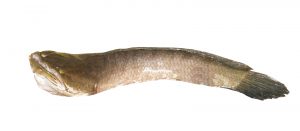Snakeheads (Channa argus) are freshwater fish that are native to India and Bangladesh but have been introduced into many other countries around the world. In some areas they are considered invasive species.
The name “snakehead” comes from their long thin elongated bodies and prominent snout with nostrils on either side of its head. They can grow up to four feet in length and weigh between one and two pounds. Their natural habitat is streams and rivers where they feed on insects and small crustaceans.
The snakehead fish’s appearance makes people think it must be very tasty and therefore popular for eating. But what do we know about this fish? Is it safe to consume? And most importantly, can you eat snakehead fish?
Here are eight answers to all your questions about snakeheads…

Snakehead facts
Snakeheads were first discovered in 1837 by William Pintard when he was exploring the Ganges river in India. He noticed an unusual looking fish which had a slimy texture and resembled a snake. Since then, snakeheads have spread throughout much of Asia, Australia and Europe.
In North America, they are found primarily along the Mississippi River in Illinois and Missouri. However, because these fish are not indigenous to the Americas, they don’t belong here naturally.
It’s important to note that there are over 100 different types of snakeheads across several genera. Although they share similar characteristics, each type has unique features like coloration and size. That means if you see someone cooking a large snakehead at home, the same won’t necessarily work for another type of snakehead.
Can you eat snakehead fish
The short answer is yes, you can! There are no reports of any serious illnesses or deaths caused by consuming snakehead fish. Even though they resemble eels, they’re only distantly related to them. Instead, they belong to the characin family, which includes more than 300 different species.
However, before you go out on a snakehead fishing expedition, make sure you learn everything you need to know about these creatures. You’ll want to understand how to identify the different species and how to tell male from female snakeheads apart. This way you can avoid accidentally catching females with eggs inside.
How does snakehead taste
Like I mentioned earlier, snakeheads look somewhat similar to eels. If you’ve ever seen a picture of a snakehead, you may even confuse one with the other. But despite having such similar appearances, they differ greatly in terms of flavor.
Unlike eels, snakeheads are milder and less bitter tasting. Because of this, they’re often used as bait fish. It’s also why they’re so popular among fishermen — they provide lots of action without being too hard to catch. Some people say snakeheads are best served grilled while others prefer frying them whole.
If you’re wondering whether you should cook snakeheads yourself, I would recommend purchasing live ones instead of pre-frozen ones. Live snakeheads will allow you to experience the full flavor of these delicious little fish.
Are snakehead poisonous
No, snakeheads aren’t poisonous. In fact, they’re completely harmless to humans and animals alike. Unlike goldfish, snakes, turtles, and tortoises, snakeheads don’t have any defenses against predators. As such, they never evolved defensive measures.
This doesn’t mean the snakehead isn’t interesting to watch. These fish swim using undulating movements made possible by electric organs located near their tails. When threatened, snakeheads emit sounds resembling those of frogs and squids. While this defense mechanism might seem strange, it works well enough to scare away larger fish and amphibians.

How to fillet a snakehead
You can purchase snakeheads whole or filet them yourself. To prepare them for cooking, rinse off dirt and debris under running water. Afterward, pat dry with paper towels and cut off the tail fin at the end. From there, take a sharp knife and remove the flesh surrounding the spine until only the bare skeleton remains.
Next, carefully slice through the backbone with a single stroke. Finally, separate the skin from the flesh using clean hands. Use scissors to trim off any remaining fins or frills.
Cooking snakehead
To preserve freshness, you should cook snakeheads shortly after purchasing them. Once prepared, store them in plastic bags and keep them in the refrigerator. Alternatively, you can freeze them for up to six months. Just thaw them overnight in the fridge before cooking.
To get started, heat oil in a pan over medium heat. Next, add salt and pepper to season the fish. Then lightly coat both sides with oil using tongs. Fry each side for five minutes per side. Remove the fish from the pan once it turns golden brown. Allow it to cool down on a plate for a few minutes before serving.
While this method works great for grilling, it doesn’t produce the right amount of fat needed to fry the fish. For this reason, I highly suggest following our step-by-step guide on preparing perfect fried snakeheads.
Our favorite snakehead recipe
As you probably guessed, snakeheads are known for their tender and juicy nature. Like other flavorful fish dishes, you should try making something simple yet delicious. Here’s our favorite recipe for a quick and easy dinner:
Ingredients:
1 pound snakehead
Salt and pepper
Olive oil
Preparation:
Rinse the snakehead thoroughly under cold water. Pat dry and cut off the tail fin.
Season the fish with salt and pepper. Heat olive oil in a non-stick skillet over medium-high heat. Carefully lay the snakehead onto the skillet and cook for 3-4 minutes per side.
Remove the cooked snakehead from the pan and place it on a plate. Serve immediately.

Conclusion
Now that you know everything about snakeheads, you can start preparing your own meals. Whether you decide to grill or deep fry them, just remember to follow the tips provided above.
One last thing to consider is that snakeheads are usually sold in markets alongside tilapia and catfish. So, it could come as a surprise that these fish are actually tasty!
Finally, check out our related articles: Blobfish, Cobia, Jack, Marlin, Tripletail and Tarpon.